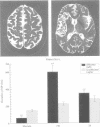Abstract
The silent period induced by transcranial magnetic stimulation of the sensorimotor cortex (Magstim 200, figure of eight coil, loop diameter 7 cm) in active muscles supplied by cranial nerves (mentalis, sternocleidomastoid, and genioglossus) was studied in 14 control subjects and nine patients with localised lesions of the sensorimotor cortex. In the patients, measurements of the silent period were also made in the first dorsal interosseus and tibialis anterior muscles. In the controls, there was a silent period in contralateral as well as ipsilateral cranial muscle and the duration of the silent period increased with increasing stimulus intensities. The mean duration of the silent period was around 140 ms in contralateral mentalis muscle and around 90 ms in contralateral sternocleidomastoid muscle at 1.2 x threshold stimulation strengths. Whereas the duration of the silent period in ipsilateral mentalis muscle was shorter than on the contralateral side it was similar on both sides in sternocleidomastoid muscle. In patients with focal lesions of the face associated primary motor cortex and corresponding central facial paresis, the silent period in mentalis muscle was shortened whereas it was unchanged or prolonged in limb muscles (first dorsal interosseus, tibialis anterior) with stimulation over the affected hemisphere. By contrast, in a patient with a lesion within the parietal cortex, the silent period in mentalis muscle was prolonged with stimulation of the affected side.
Full text
PDF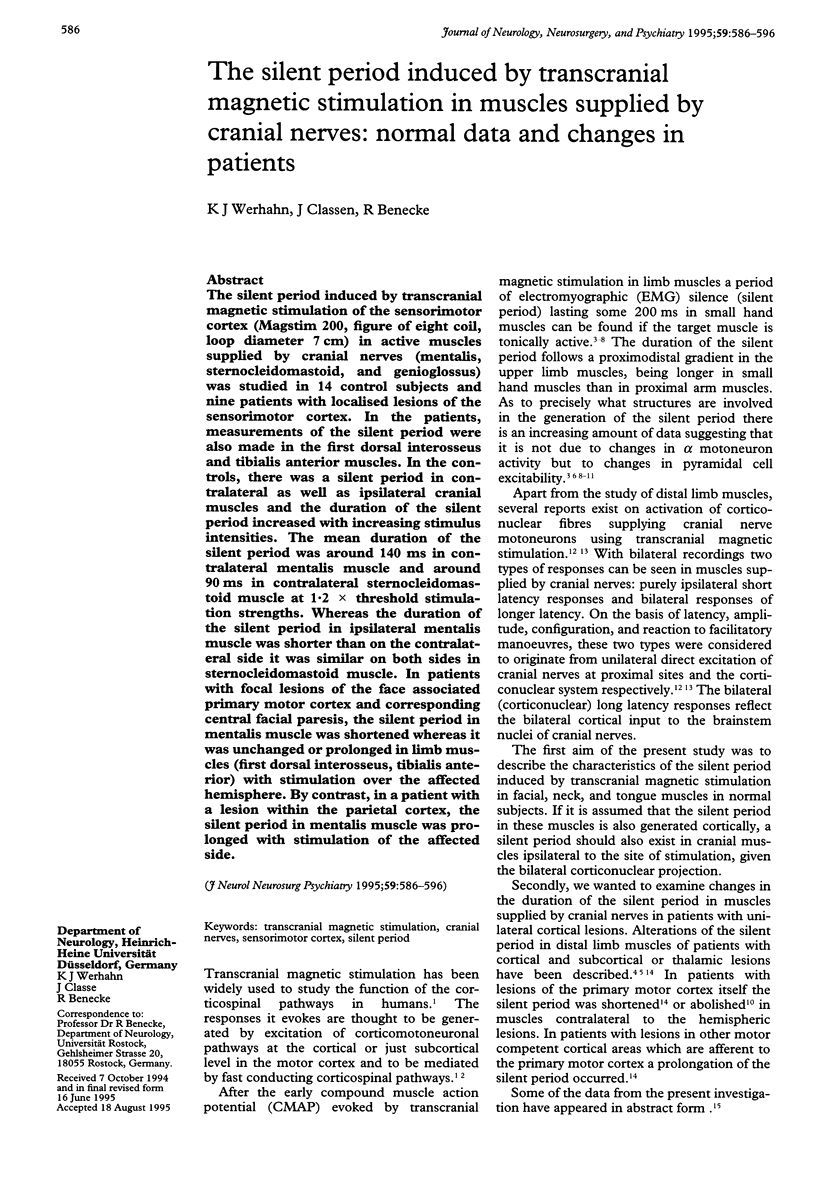
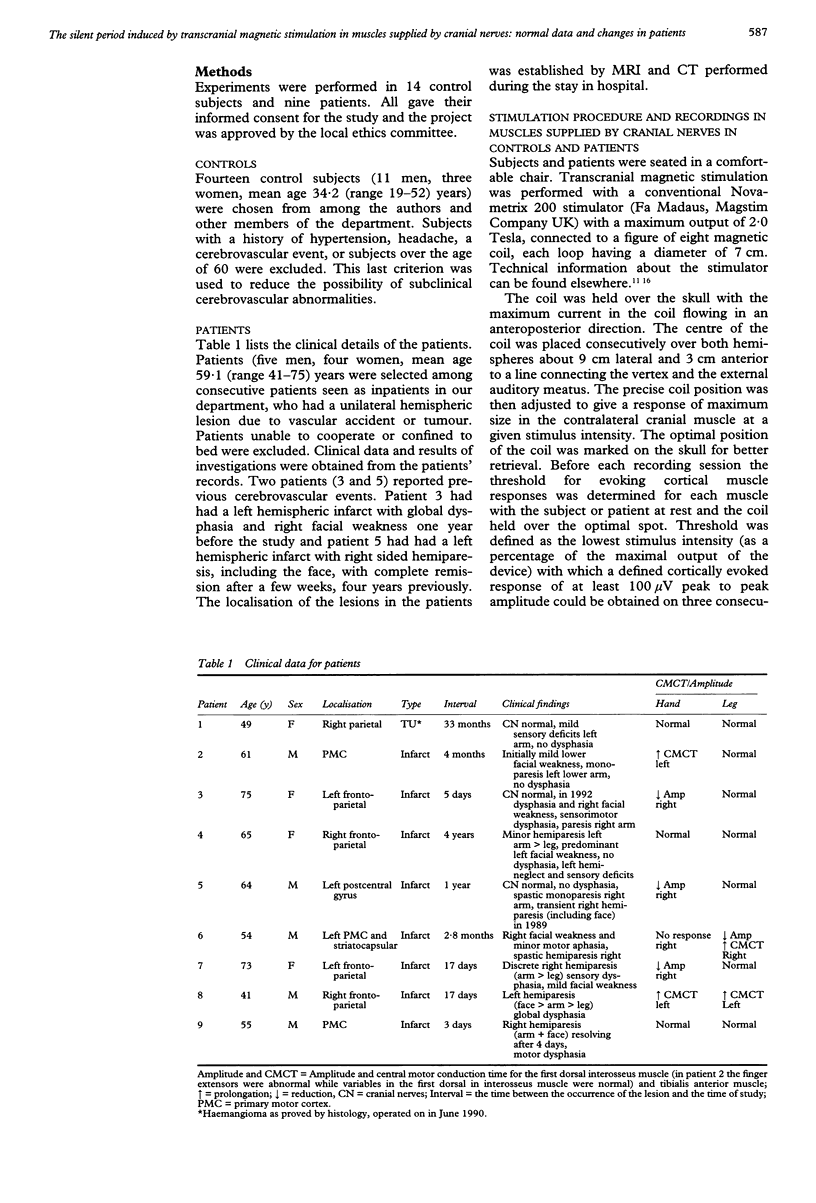
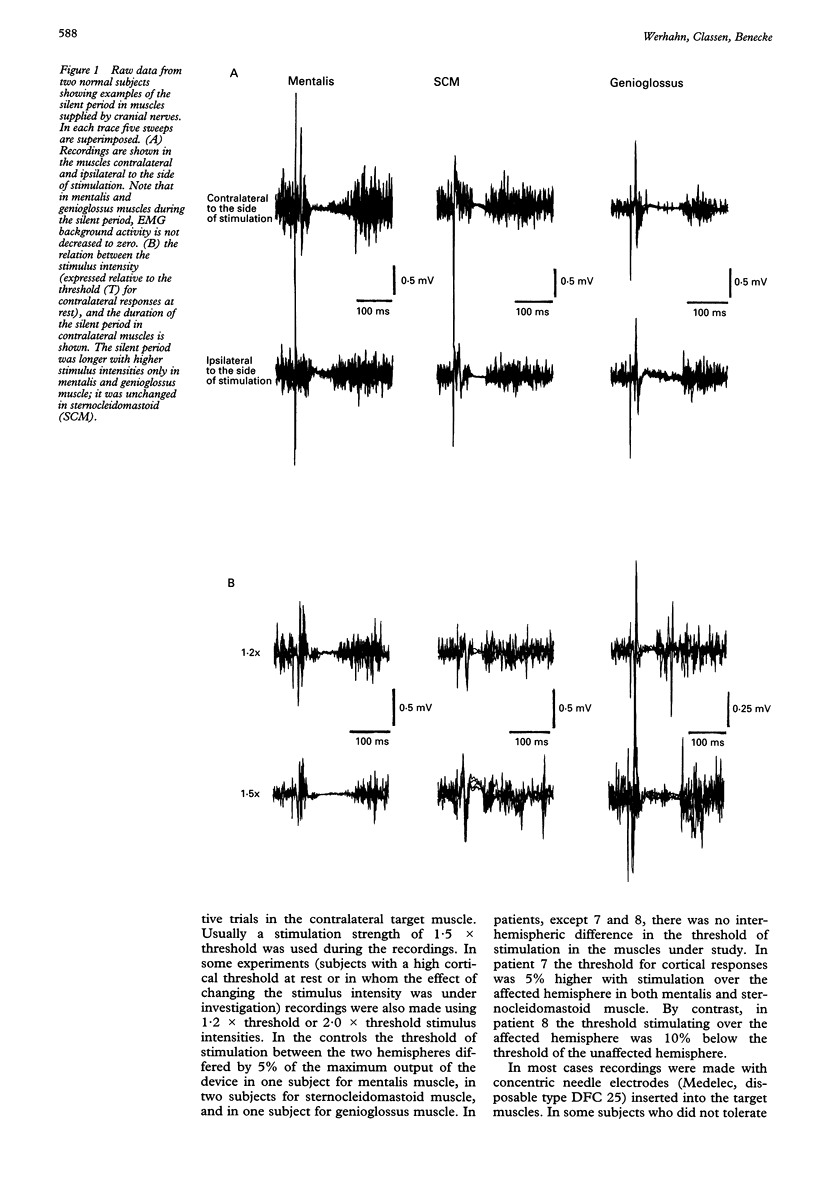
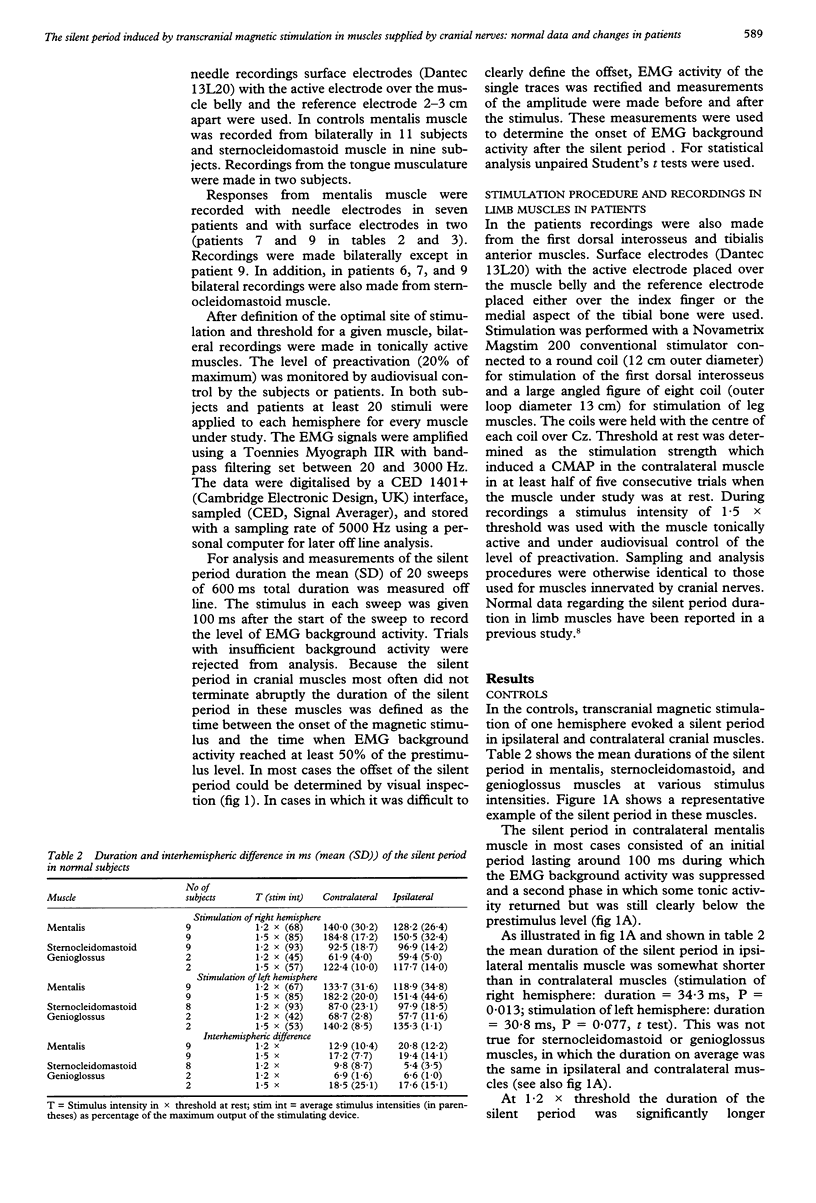
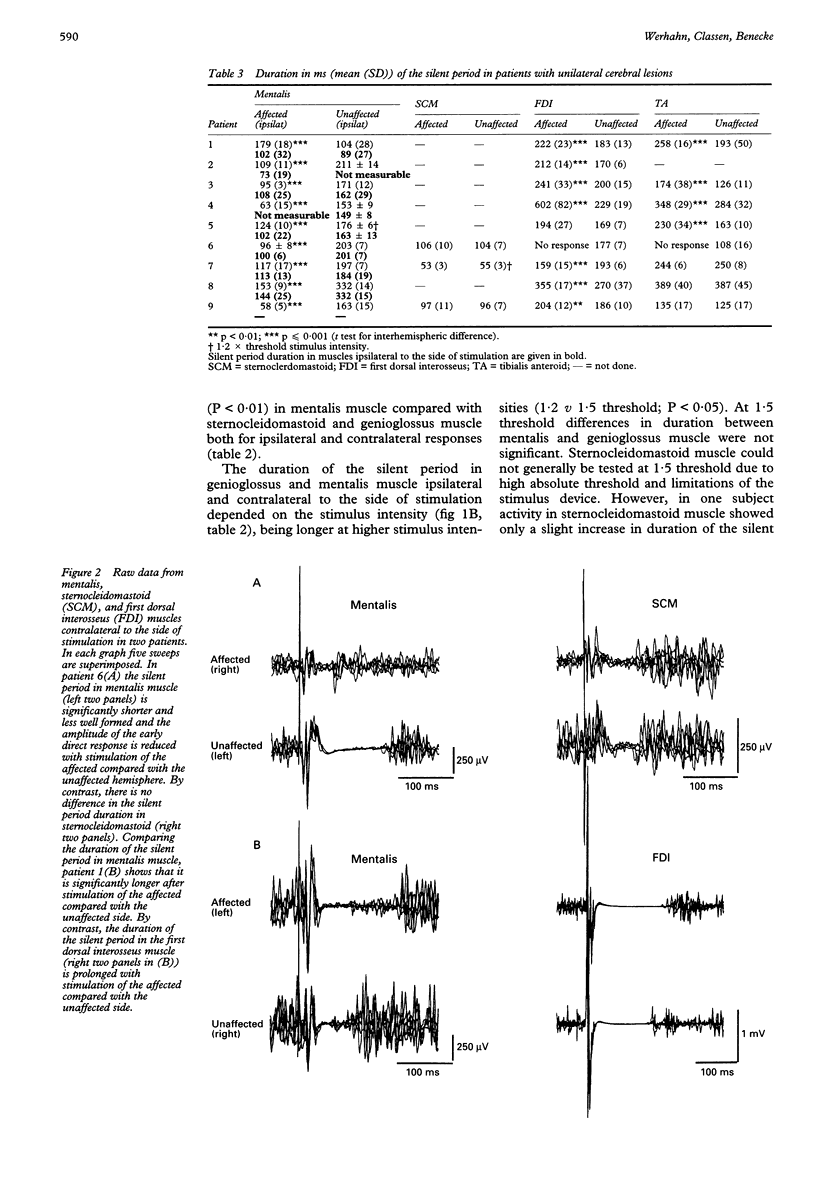
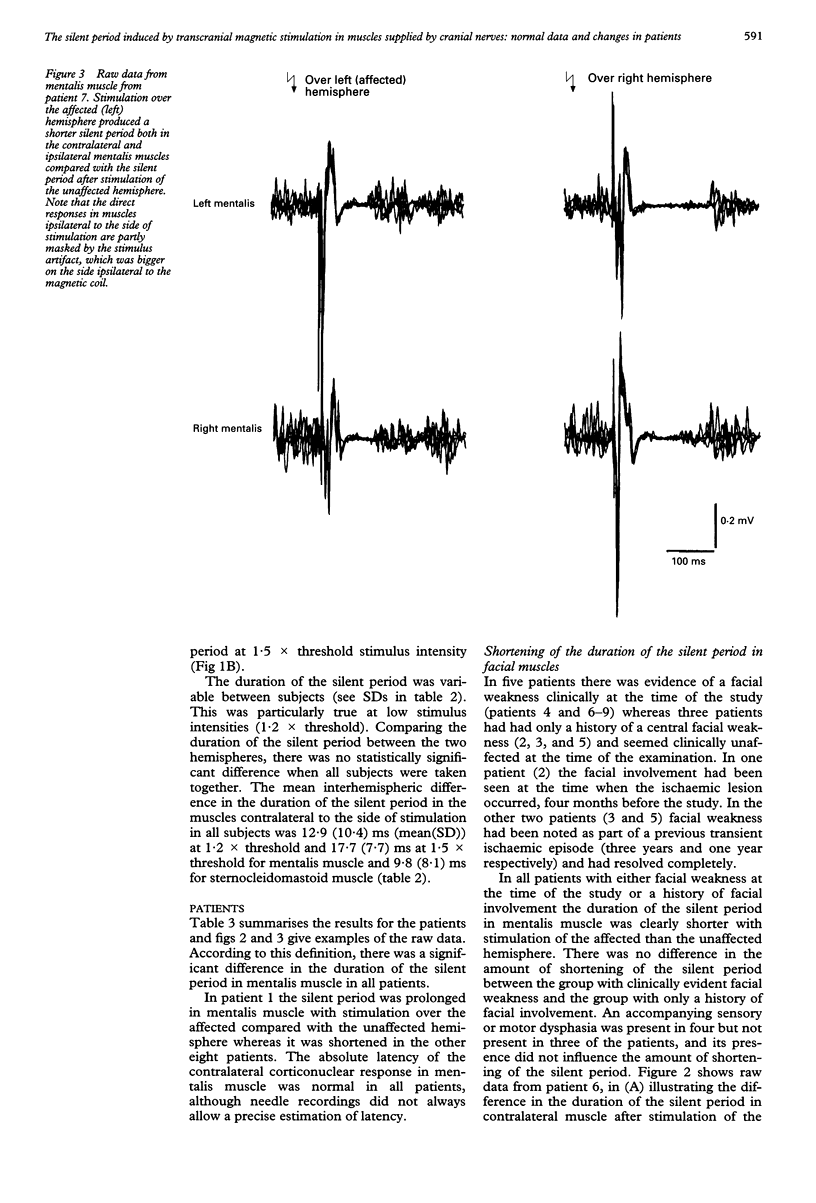
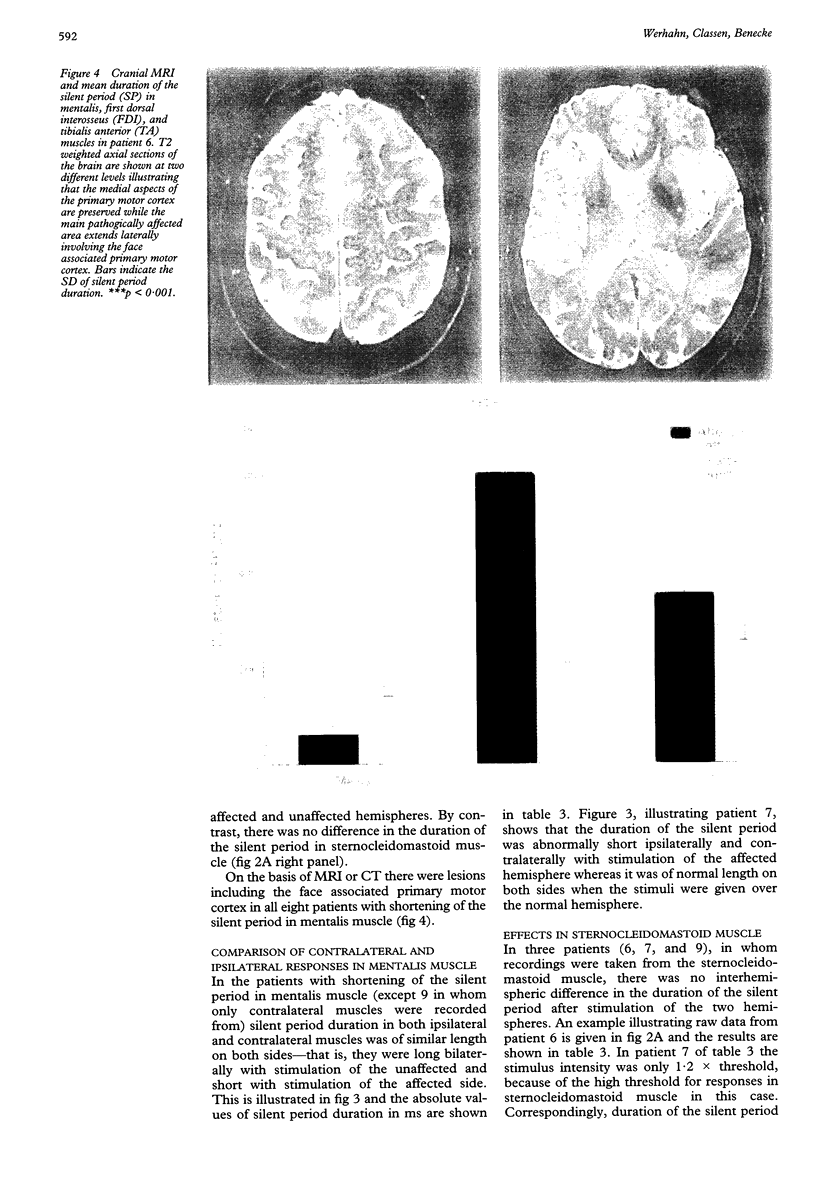
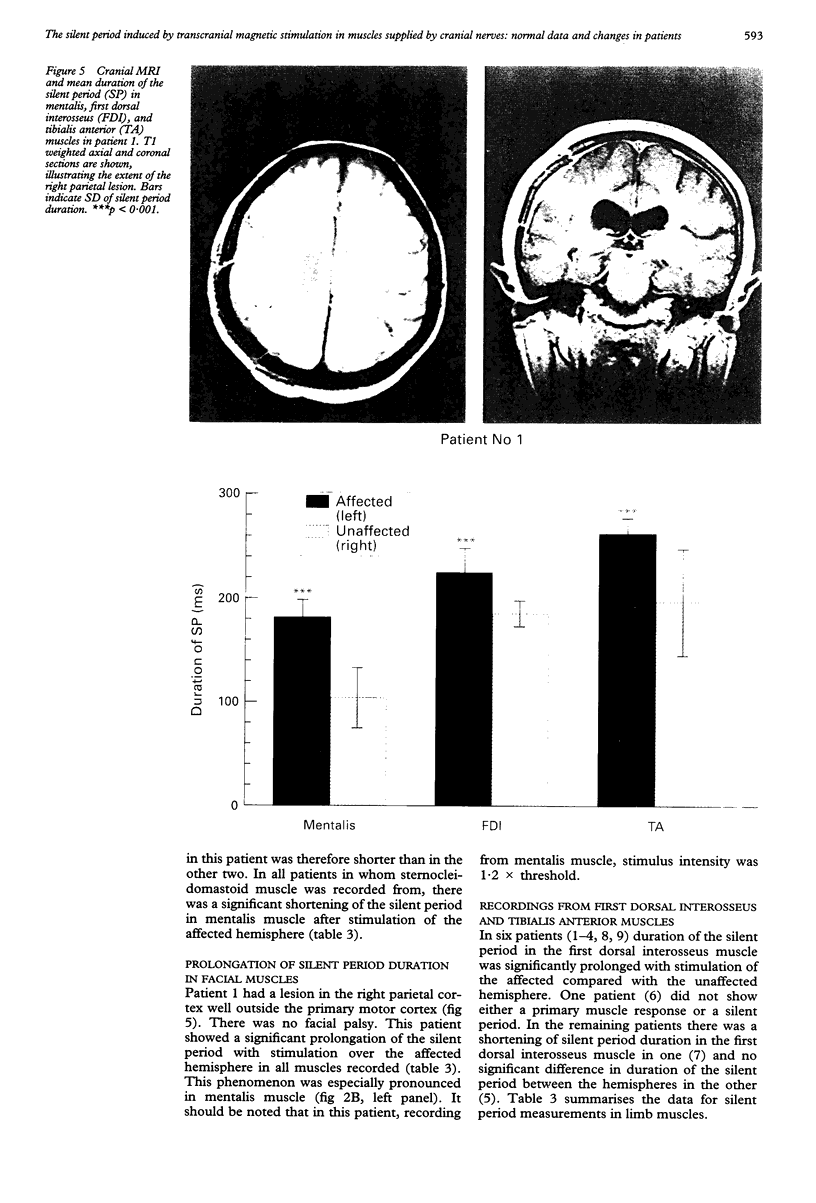
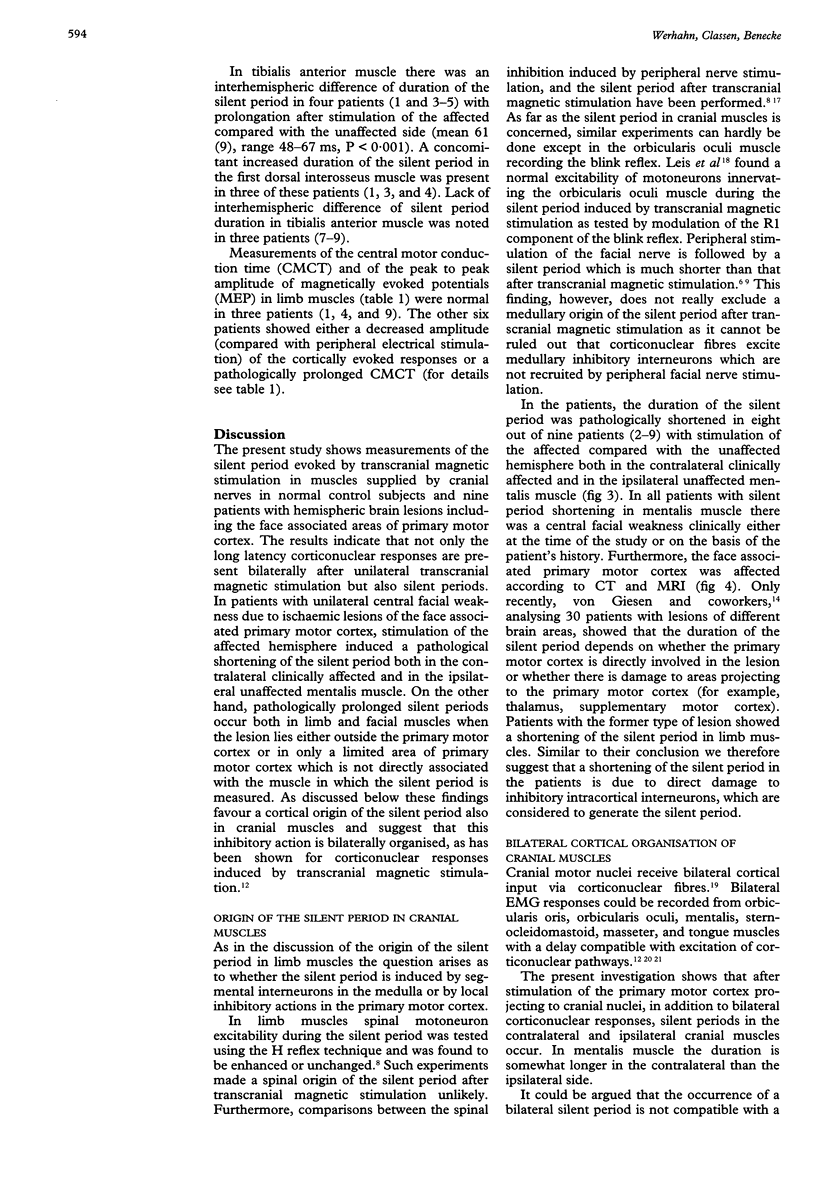
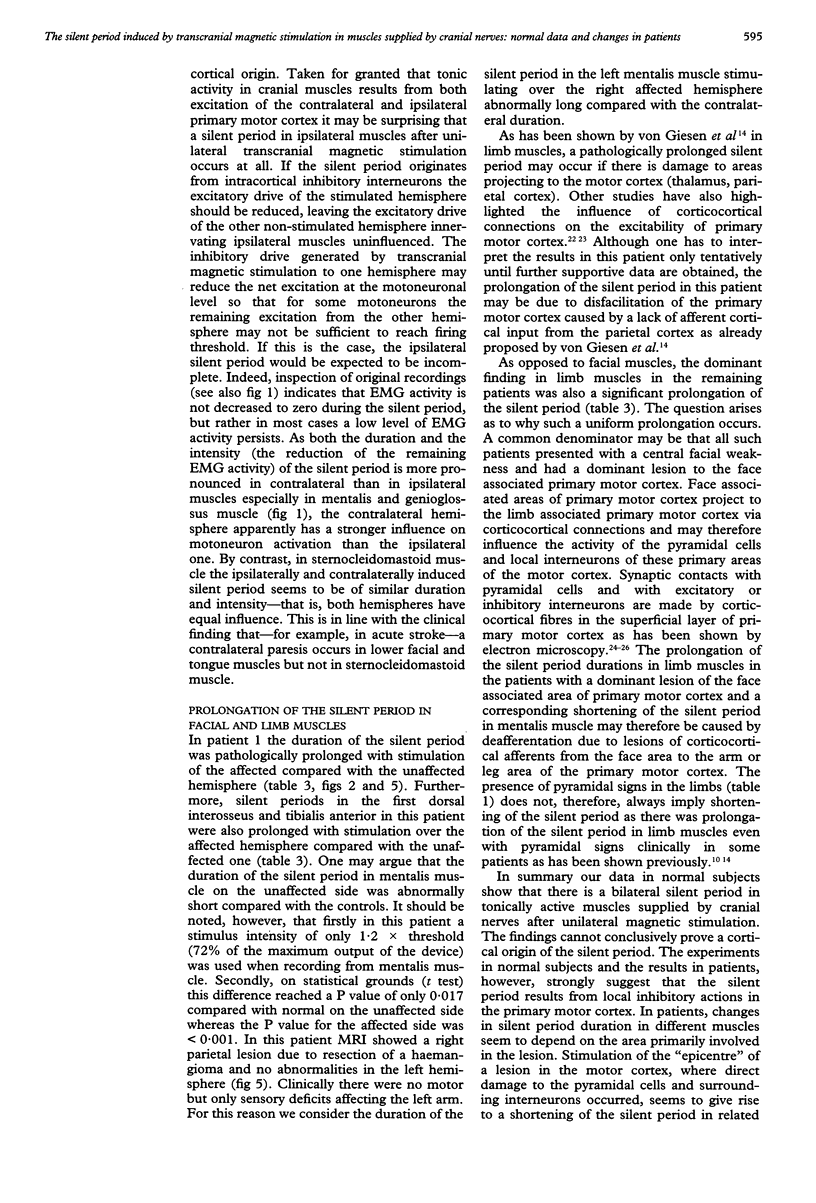
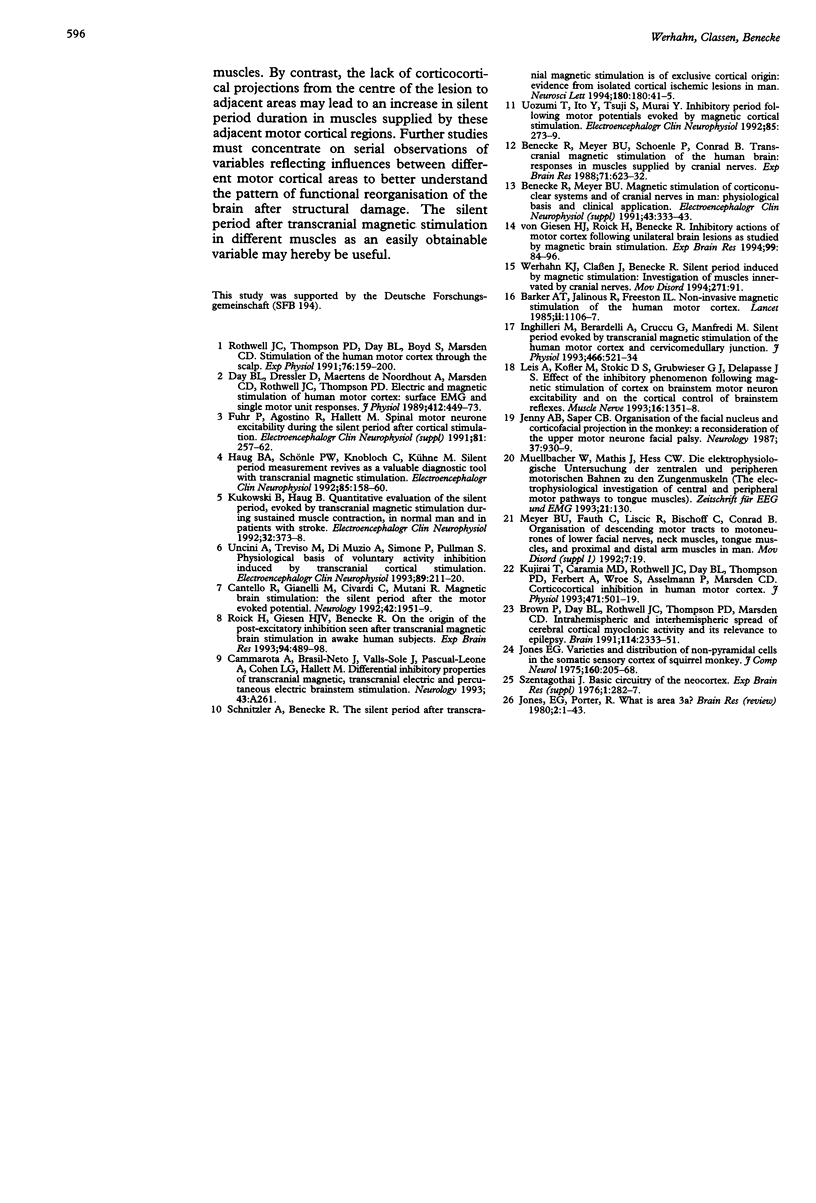
Images in this article
Selected References
These references are in PubMed. This may not be the complete list of references from this article.
- Benecke R., Meyer B. U., Schönle P., Conrad B. Transcranial magnetic stimulation of the human brain: responses in muscles supplied by cranial nerves. Exp Brain Res. 1988;71(3):623–632. doi: 10.1007/BF00248756. [DOI] [PubMed] [Google Scholar]
- Brown P., Day B. L., Rothwell J. C., Thompson P. D., Marsden C. D. Intrahemispheric and interhemispheric spread of cerebral cortical myoclonic activity and its relevance to epilepsy. Brain. 1991 Oct;114(Pt 5):2333–2351. doi: 10.1093/brain/114.5.2333. [DOI] [PubMed] [Google Scholar]
- Cantello R., Gianelli M., Civardi C., Mutani R. Magnetic brain stimulation: the silent period after the motor evoked potential. Neurology. 1992 Oct;42(10):1951–1959. doi: 10.1212/wnl.42.10.1951. [DOI] [PubMed] [Google Scholar]
- Colombo M., Mannucci P. M., Carnelli V., Savidge G. F., Gazengel C., Schimpf K. Transmission of non-A, non-B hepatitis by heat-treated factor VIII concentrate. Lancet. 1985 Jul 6;2(8445):1–4. doi: 10.1016/s0140-6736(85)90055-8. [DOI] [PubMed] [Google Scholar]
- Day B. L., Dressler D., Maertens de Noordhout A., Marsden C. D., Nakashima K., Rothwell J. C., Thompson P. D. Electric and magnetic stimulation of human motor cortex: surface EMG and single motor unit responses. J Physiol. 1989 May;412:449–473. doi: 10.1113/jphysiol.1989.sp017626. [DOI] [PMC free article] [PubMed] [Google Scholar]
- Fuhr P., Agostino R., Hallett M. Spinal motor neuron excitability during the silent period after cortical stimulation. Electroencephalogr Clin Neurophysiol. 1991 Aug;81(4):257–262. doi: 10.1016/0168-5597(91)90011-l. [DOI] [PubMed] [Google Scholar]
- Haug B. A., Schönle P. W., Knobloch C., Köhne M. Silent period measurement revives as a valuable diagnostic tool with transcranial magnetic stimulation. Electroencephalogr Clin Neurophysiol. 1992 Apr;85(2):158–160. doi: 10.1016/0168-5597(92)90081-l. [DOI] [PubMed] [Google Scholar]
- Inghilleri M., Berardelli A., Cruccu G., Manfredi M. Silent period evoked by transcranial stimulation of the human cortex and cervicomedullary junction. J Physiol. 1993 Jul;466:521–534. [PMC free article] [PubMed] [Google Scholar]
- Jenny A. B., Saper C. B. Organization of the facial nucleus and corticofacial projection in the monkey: a reconsideration of the upper motor neuron facial palsy. Neurology. 1987 Jun;37(6):930–939. doi: 10.1212/wnl.37.6.930. [DOI] [PubMed] [Google Scholar]
- Jones E. G., Porter R. What is area 3a? Brain Res. 1980 May;203(1):1–43. doi: 10.1016/0165-0173(80)90002-8. [DOI] [PubMed] [Google Scholar]
- Jones E. G. Varieties and distribution of non-pyramidal cells in the somatic sensory cortex of the squirrel monkey. J Comp Neurol. 1975 Mar 15;160(2):205–267. doi: 10.1002/cne.901600204. [DOI] [PubMed] [Google Scholar]
- Kujirai T., Caramia M. D., Rothwell J. C., Day B. L., Thompson P. D., Ferbert A., Wroe S., Asselman P., Marsden C. D. Corticocortical inhibition in human motor cortex. J Physiol. 1993 Nov;471:501–519. doi: 10.1113/jphysiol.1993.sp019912. [DOI] [PMC free article] [PubMed] [Google Scholar]
- Kukowski B., Haug B. Quantitative evaluation of the silent period, evoked by transcranial magnetic stimulation during sustained muscle contraction, in normal man and in patients with stroke. Electromyogr Clin Neurophysiol. 1992 Jul-Aug;32(7-8):373–378. [PubMed] [Google Scholar]
- Leis A. A., Kofler M., Stokic D. S., Grubwieser G. J., Delapasse J. S. Effect of the inhibitory phenomenon following magnetic stimulation of cortex on brainstem motor neuron excitability and on the cortical control of brainstem reflexes. Muscle Nerve. 1993 Dec;16(12):1351–1358. doi: 10.1002/mus.880161213. [DOI] [PubMed] [Google Scholar]
- Roick H., von Giesen H. J., Benecke R. On the origin of the postexcitatory inhibition seen after transcranial magnetic brain stimulation in awake human subjects. Exp Brain Res. 1993;94(3):489–498. doi: 10.1007/BF00230207. [DOI] [PubMed] [Google Scholar]
- Uncini A., Treviso M., Di Muzio A., Simone P., Pullman S. Physiological basis of voluntary activity inhibition induced by transcranial cortical stimulation. Electroencephalogr Clin Neurophysiol. 1993 Aug;89(4):211–220. doi: 10.1016/0168-5597(93)90098-a. [DOI] [PubMed] [Google Scholar]
- Uozumi T., Ito Y., Tsuji S., Murai Y. Inhibitory period following motor potentials evoked by magnetic cortical stimulation. Electroencephalogr Clin Neurophysiol. 1992 Aug;85(4):273–279. doi: 10.1016/0168-5597(92)90116-s. [DOI] [PubMed] [Google Scholar]
- von Giesen H. J., Roick H., Benecke R. Inhibitory actions of motor cortex following unilateral brain lesions as studied by magnetic brain stimulation. Exp Brain Res. 1994;99(1):84–96. doi: 10.1007/BF00241414. [DOI] [PubMed] [Google Scholar]



